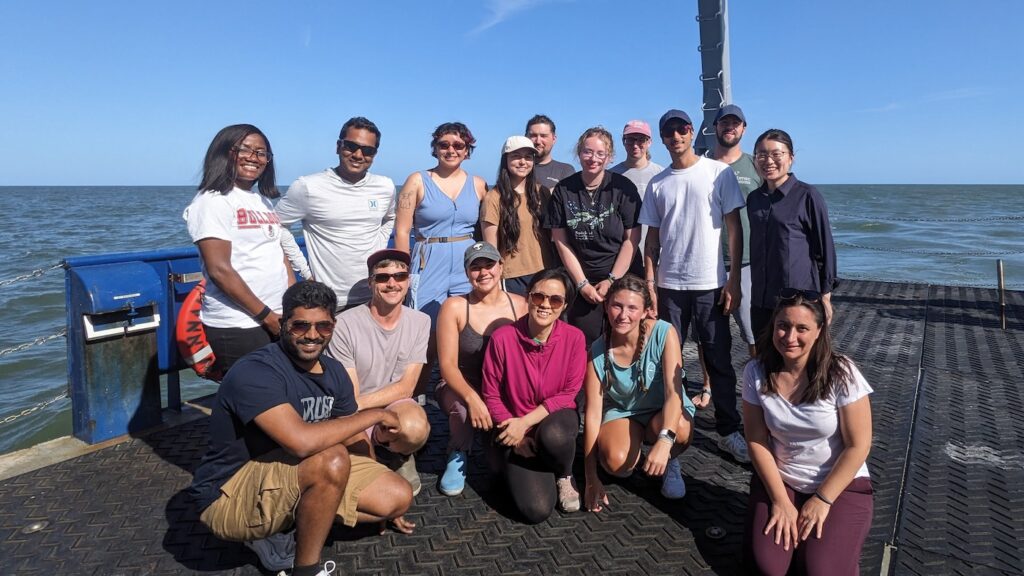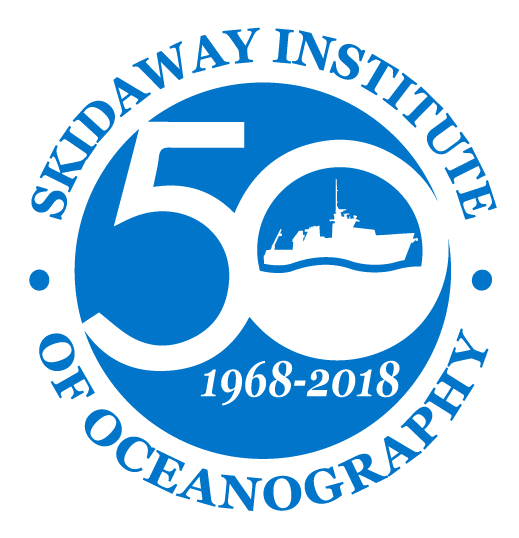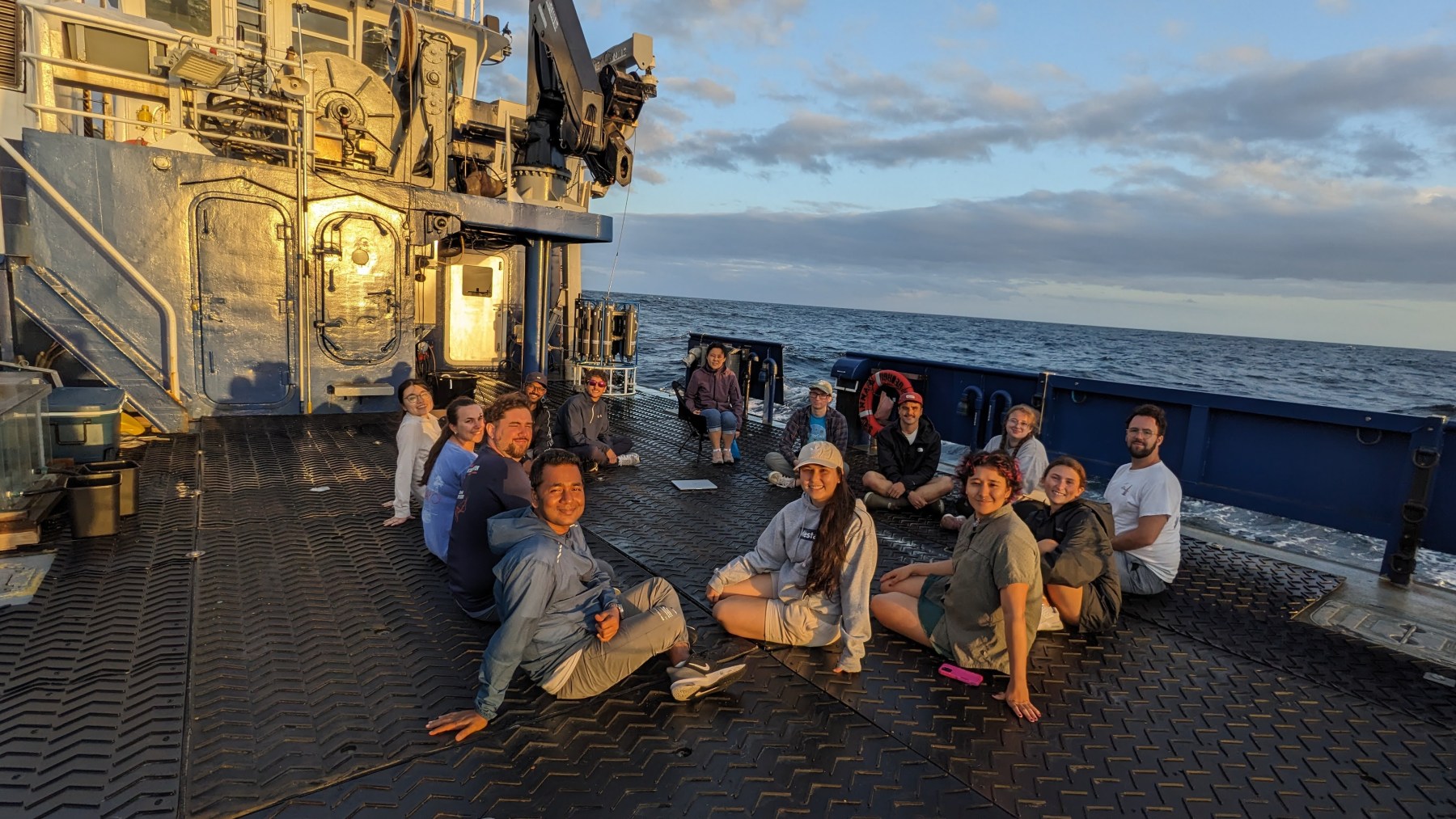
A group of 10 scientists from institutions across the University System of Georgia (USG) joined researchers from the University of Georgia Skidaway Institute of Oceanography’s (SkIO) Rivero-Calle Lab for an educational cruise aboard the Research Vessel Savannah from April 28-30, 2025.
The three-day cruise was designed to enhance the early-career scientists’ understanding of optical oceanography and to provide a hands-on opportunity to learn new skills using a variety of instruments for collecting oceanographic data.
The cruise also offered participants opportunities to network with USG peers interested in optical oceanography. Participating scientists included students from Georgia College and State University (GCSU), Georgia Institute of Technology (Georgia Tech), Georgia Southern University (GSU), Savannah State University (SSU), and the University of Georgia (UGA), along with a faculty member from Georgia Gwinnett College (GGC) and a postdoctoral researcher from Georgia Tech.
“I wanted to provide a unique opportunity for early career scientists in the USG system to learn about optical oceanography and about the new systems that we have implemented on the R/V Savannah, but also to network and collaborate with peers from other disciplines because marine science research is inherently interdisciplinary,” said Sara Rivero-Calle, an assistant professor at SkIO.
Rivero-Calle Cruise — April 2025
“Even though the cruise topic was very specific and it was happening at a busy time of the year, the end of the semester, we had more applicants than berths available,” Rivero-Calle added. “The cruise was designed so that participants would see and experience different aspects of the oceanography of the South Atlantic Bight, from marshes and calm turbid waters, to the strong influence of the Gulf Stream current, to the clear waters beyond it.”
Over the course of the cruise, the Savannah stopped at a series of sea stations off the coast of Georgia. The scientists identified stations based on the paths of several ocean color satellites and timed stops up with the satellite overpasses. At each station, scientists deployed a variety of oceanographic instruments to pair with and validate information gathered by the satellites.
“It was great to see how the participants grew each day, learning new skills and gradually feeling empowered to lead activities,” said Rivero-Calle.
Some of the instruments used by the science team include the Hyperpro Profiller II, Spectravista Handheld Radiometer, and a TriOS radiometer system coupled with a solar-tracking device, among others. At each station, the team also conducted casts using a conductivity, temperature, and depth (CTD) rosette to collect water samples and profile ocean conditions.
Additionally, the cruise served as a test run for the Savannah’s new flow-through system, which automatically collects data on more than 14 biogeochemical and optical variables as the ship travels. The data collected by the system is accessible in real time through the innovative CORIOLIX data presence system. These improvements are part of a National Science Foundation (NSF) grant to Rivero-Calle to upgrade the Savannah research and educational capabilities.
“It was really cool to have this unique opportunity to not only go out and do field work but also interact with others across oceanography disciplines,” said Kali Kater, a first-year doctoral student in Ocean Science and Engineering at Georgia Tech.
“I think the best part of the cruise was that I was able to gain hands-on experience with every aspect of the experiments we ran,” added Qing Shao, a professor of physics at GGC.
The cruise aboard SkIO’s 104-foot Savannah was funded by a continuing 2019 appropriation from the Georgia Legislature to support ship days for educational purposes for all students and faculty within the USG.
The full list of participating guests includes:
- Yumi Abe, postdoctoral researcher, Georgia Tech
- Mitchelle Agnosi, graduate student, UGA
- Jonathan Austin, undergraduate student, SSU
- Patrick Duffy, graduate student, UGA
- Alivia Eng, graduate student, Georgia Tech
- Kali Kater, graduate student, Georgia Tech
- Elise Mirabella, undergraduate student, GCSU
- Isabelle Osuna, graduate student, Georgia Tech
- Olly Pettes, graduate student, GSU
- Qing Shao, faculty member, GGC
The full list of participating Rivero-Calle Lab members includes:
- Srinivas Kolluru, postdoctoral researcher
- Benjamin Lowin, graduate student
- Masud-Ul-Alam, graduate student
- Ashley Ohall, graduate student
- Andrea Pellegrino, visiting graduate student from Italy
- Sara Rivero-Calle, assistant professor
About SkIO
The UGA Skidaway Institute of Oceanography (SkIO) is a multidisciplinary research and education institution located on Skidaway Island near Savannah, Georgia. The Institute was founded in 1967 with a mission to conduct research in all fields of oceanography. In 2013, SkIO was merged with the University of Georgia. The campus serves as a gateway to coastal and marine environments for programs throughout the University System. The Institute’s primary goals are to further the understanding of marine and environmental processes, conduct leading-edge research on coastal and marine systems, and train tomorrow’s scientists. For more information, visit www.skio.uga.edu.



